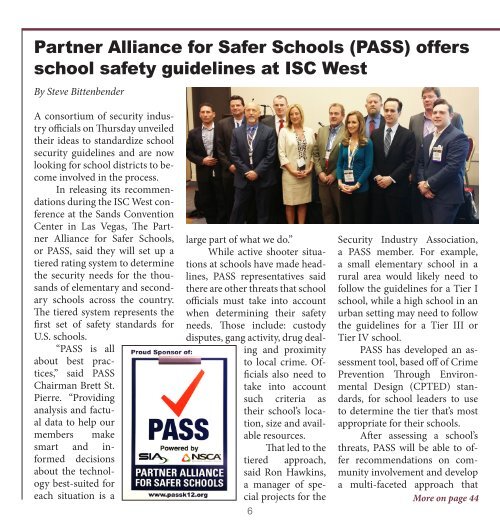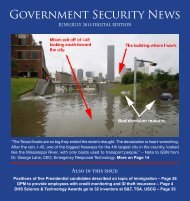Government Security News April May 2015
Create successful ePaper yourself
Turn your PDF publications into a flip-book with our unique Google optimized e-Paper software.
Partner Alliance for Safer Schools (PASS) offers<br />
school safety guidelines at ISC West<br />
By Steve Bittenbender<br />
A consortium of security industry<br />
officials on Thursday unveiled<br />
their ideas to standardize school<br />
security guidelines and are now<br />
looking for school districts to become<br />
involved in the process.<br />
In releasing its recommendations<br />
during the ISC West conference<br />
at the Sands Convention<br />
Center in Las Vegas, The Partner<br />
Alliance for Safer Schools,<br />
or PASS, said they will set up a<br />
tiered rating system to determine<br />
the security needs for the thousands<br />
of elementary and secondary<br />
schools across the country.<br />
The tiered system represents the<br />
first set of safety standards for<br />
U.S. schools.<br />
“PASS is all<br />
about best practices,”<br />
said PASS<br />
Chairman Brett St.<br />
Pierre. “Providing<br />
analysis and factual<br />
data to help our<br />
members make<br />
smart and informed<br />
decisions<br />
about the technology<br />
best-suited for<br />
each situation is a<br />
large part of what we do.”<br />
While active shooter situations<br />
at schools have made headlines,<br />
PASS representatives said<br />
there are other threats that school<br />
officials must take into account<br />
when determining their safety<br />
needs. Those include: custody<br />
disputes, gang activity, drug dealing<br />
and proximity<br />
to local crime. Officials<br />
also need to<br />
take into account<br />
such criteria as<br />
their school’s location,<br />
size and available<br />
resources.<br />
That led to the<br />
tiered approach,<br />
said Ron Hawkins,<br />
a manager of special<br />
projects for the<br />
6<br />
<strong>Security</strong> Industry Association,<br />
a PASS member. For example,<br />
a small elementary school in a<br />
rural area would likely need to<br />
follow the guidelines for a Tier I<br />
school, while a high school in an<br />
urban setting may need to follow<br />
the guidelines for a Tier III or<br />
Tier IV school.<br />
PASS has developed an assessment<br />
tool, based off of Crime<br />
Prevention Through Environmental<br />
Design (CPTED) standards,<br />
for school leaders to use<br />
to determine the tier that’s most<br />
appropriate for their schools.<br />
After assessing a school’s<br />
threats, PASS will be able to offer<br />
recommendations on community<br />
involvement and develop<br />
a multi-faceted approach that<br />
More on page 44







